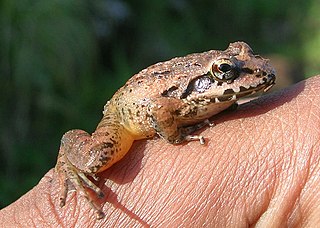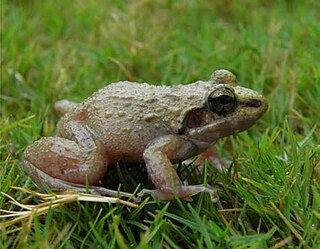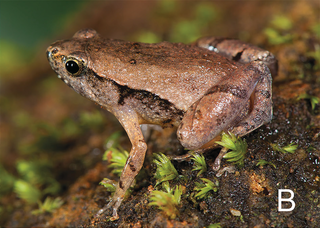
Indirana is a genus of frogs in the family Ranixalidae. These frogs are endemic to the Western Ghats of India. They are sometimes known under the common name Indian frogs, whereas members of their parent family are named "leaping frogs".

Indirana beddomii, Beddome's leaping frog, Beddome's Indian frog, or simply Beddome's frog, is a species of frog found in the Western Ghats. They are usually detected by their long leaps as they flush from the ground when disturbed. The species is named after the naturalist Richard Henry Beddome.

Indirana semipalmata is a species of frog endemic to the Western Ghats region of southern India. They are small frogs, reaching lengths of about 36 mm (1.4 in) from snout to vent. The species breeds during the monsoons, laying their eggs on moist rocks and tree bark. Their tadpoles are terrestrial – hatching, feeding, and undergoing metamorphosis without ever entering any standing bodies of water.

Indirana leithii is a species of frog in the family Ranixalidae. It is endemic to the northern Western Ghats of India. As currently defined, its range is restricted to the states of Maharashtra and southern Gujarat; earlier records elsewhere refer to other species.

Walkerana diplosticta, also known as the spotted leaping frog, Malabar Indian frog, rufous leaf-hopper frog, and Günther's frog, is a species of frog in the family Ranixalidae. It is endemic to the Western Ghats south of the Palghat Gap and only known with certainty from the states of Kerala and Tamil Nadu, India. Localities with confirmed records include the Kalakkad Mundanthurai Tiger Reserve.
Indirana gundia is a species of frog found in the Western Ghats of India. It is only known from its type locality, Kempholey, Karnataka. Indirana gundia is listed among "Top 100 EDGE Amphibians". It represents a family that has been evolving independently in India for almost 50 million years.
Cornufer browni is a species of frog in the family Ceratobatrachidae. It is endemic to Papua New Guinea. It has been observed between 100 and 200 meters above sea level and between 1100 and 1300 meters above sea level.

Raorchestes griet is a species of frog in the family Rhacophoridae. It is endemic to the Western Ghats south of the Palghat Gap in Kerala and Tamil Nadu states, India. The specific name griet honours Griet Decock, spouse of Franky Bossuyt, the scientist who described the species. The common name Griet bush frog has been coined for it.

Pseudophilautus popularis, the common shrub frog, is a species of frogs in the family Rhacophoridae.

Raorchestes anili, known commonly as Anil's bush frog, is a species of frog in the family Rhacophoridae.

Indirana chiravasi is a species of frog endemic to the Western Ghats of India. It is only known from its type locality, the laterite plateaus by the hill-station of Amboli, Maharashtra. It was described in 2014 by a team of three scientists from IISER, Pune and MES Abasaheb Garware College.

Microhyla mihintalei is a species of frog in the family Microhylidae. It is endemic to Sri Lanka.
Walkerana muduga, also known as the Muduga mountain leaping frog or Muduga leaping frog, is a species of frog in the family Ranixalidae. It is endemic to the Western Ghats of India and known from the Elivai Malai range, north of the Palghat Gap in Tamil Nadu. All other known species of Walkerana occur south of the Palghat Gap, and molecular data suggest that Walkerana muduga is deeply divergent from the more southern species. However, there is another, as yet undescribed lineage from north of the Palghat Gap that is known from a single, poorly preserve specimen.

Nyctibatrachus manalari, the Manalar night frog, is a species of frog in the robust frog family Nyctibatrachidae. It was described in 2017, along with six other species in its genus, by the herpetologist Sonali Garg and her colleagues. A small frog, it has an adult male snout–vent length of 13.1–15.4 mm (0.52–0.61 in). It is mainly reddish-brown in color, with a pale patch on the snout, lighter undersides, and dark brown horizontal lines on the limbs. When preserved in ethanol, it is mostly grey to greyish-brown, with grayish-white undersides.

Nyctibatrachus robinmoorei, also known as Robin Moore's night frog or the Tirunelveli wrinkled frog, is a species of frog in the family Nyctibatrachidae, commonly known as the robust frogs. It was described in 2017, along with six other species in its genus, by the herpetologist Sonali Garg and her colleagues. A small frog, it has an adult male snout–vent length of 12.2–13.4 mm (0.48–0.53 in). It is mainly reddish-brown, with a light grey underside, light orangish-brown bands running from the eyes to the middle of the back, light brown limbs, and darker brown hands and feet. When preserved in ethanol, it is mostly brown, with light greyish-white undersides and light greyish-brown limbs.

Nyctibatrachus radcliffei, also known as Radcliffe's night frog or the Thiashola wrinkled frog, is a species of frog in the robust frog family Nyctibatrachidae. It was described in 2017, along with six other species in its genus, by the herpetologist Sonali Garg and her colleagues. A medium-sized frog for its genus, it has an adult male snout–vent length of 32.8–38.3 mm (1.29–1.51 in). It is mainly reddish-brown, with a light flesh-red coloured underside, light brown limbs, and dark grey hands and feet. When preserved in ethanol, it is mostly dark grey, with grayish-white undersides.

Microhyla darreli is a species of frog in the family Microhylidae, the narrow-mouthed frogs. It is endemic to the Western Ghats south of the Palghat Gap in southern India. It is named for Darrel Frost, an American herpetologist, in recognition of the online database Amphibian Species of the World that he maintains. Accordingly, common name Darrel's chorus frog has been coined for this species.

Ghatixalus asterops, the Ghat tree frog or starry-eyed Ghat tree frog, is a species of frog in the subfamily Rhacophorinae. It is endemic to India's Western Ghat mountains, specifically the Palani Hills and south of the Palghat Gaps.
Indirana salelkari, the Netravali leaping frog, is a species of frog in the family Ranixalidae. It is endemic to India's Western Ghat mountains.
The rocky terrain leaping frog or Suganthagiri leaping frog is a frog in the family Ranixalidae. It is endemic to Kerala, India in the Western Ghat mountains.














